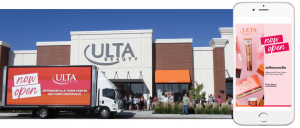The main aim of digital signage has always been to provide the right information at the right time. With a Digital Out-of-Home dynamic campaign in the mix, that goal becomes significantly easier to achieve!
Consumers appreciate information they need at any given moment in time. This is exactly what a dynamic campaign provides, using real-time data to bring the content its viewer welcomes open-handed. With that in mind, it’s hardly a surprise that dynamic campaigns are more effective than their static counterparts. In fact, they have a 48% higher success rate over static campaigns rotating regular offline content. Let’s take a look at some of the ways dynamic campaigns manage to achieve this advantage.
Real-time information
The key to any dynamic campaign is providing information the user can rely on at any given time. In essence, it’s all about bringing local data that you have into the spotlight at exactly the right time.
Content adjusting to the day of the week and time of day is a good start. Adjusting to weather conditions is the next further step. Olay Skin Care intended to run a dynamic campaign based on real-time weather data where the content would change to provide skin care tips in 21 pre-established weather scenarios.
Sources of real-time data can also come from online social media feeds, scores of games relevant at the time, updates on important events taking place, etc. For this purpose, using online content which updates itself is a breeze. The key is choosing the right content.
With words, less is more
While dynamic campaigns call on more work and effort, it doesn’t mean the data provided should be more complex. Short and concise information does the trick and only a few words are enough to land your message.
The aforementioned Olay Skin Care campaign is a good example for complexity. While their idea of skin care tips based on weather conditions is brilliant in theory, it wasn’t executed well enough. The campaign was rushed and content couldn’t be properly created in time. In the end, the campaign used too much text for each single tip, making it less effective. Once they saw the lack of success, the company switched back to static campaigns.
Whether it’s dynamic or static digital signage, the rule of simplicity always applies. Around six words should be enough to get the message across immediately. Anything largely over that number would require more than a single glance to comprehend.
Simplicity is vital
When creating a dynamic campaign, a company or business must exercise care. While there are certain templates to follow, such as adapting content based on weather conditions or time of day, it’s important to fully play through the scenario.
Weather or temperature based content doesn’t make much sense in locations or seasons where weather patterns and temperatures are much of the same. Thus, a different factor should be used as the base for a dynamic campaign.
In establishing scenarios where the content changes, complexity won’t do much either. For the Olay Skin Care campaign, 21 weather scenarios seems like much. Using fewer scenarios would’ve made the campaign easier to prepare and implement.
The value of location
Location-based advertising is another factor applicable to dynamic campaigns. Firstly, it’s highly effective for a display to show content relevant to its location. Additionally, it’s also useful for displays in motion, in public transportation for instance. Using location, displays can inform travelers about their current location and local points of interest, for a start.
Another example is shadowfencing, referring to a mobile billboard which changes its content based on the location of the vehicle. It is then followed by mobile ads on devices of the audience near the mobile billboard. Its key advantage is to easily advertise to a specific audience. Instead of waiting for the audience to approach the advertisement, shadowfencing brings the advertisement to the audience and expands its reach. In essence, it’s a higher form of geofencing which you can already apply in your own campaigns easily.
Dynamic outdoor advertising is the future. While it may be primarily used by bigger brands, it is gradually spreading and becoming more available for everyone. Its success rate speaks for itself! And although it might not overtake static campaigns showing regular content on a loop, a dynamic campaign in any form can be a positive addition to your outdoor content rotation.









